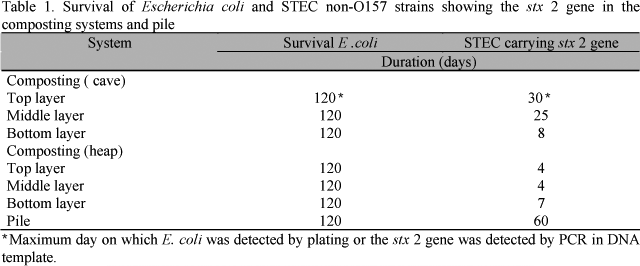To determine the fate of Shiga toxigenic Escherichia coli (STEC) non-O 157 in composted manure from naturally colonized cattle, fresh manure was obtained from three cows carrying non-O157 STEC strains possessing the stx2 gene. Two composting systems were used: a 0.6m deep cave opened in the soil and an one meter high solid manure heap in a pyramidal architecture. Every day, for the 10 first days, and every five days for a month, one manure sample from three different points in both systems was collected and cultured to determine the presence of E. coli and the presence of the stx 2 gene in the cells. The temperature was verified at each sampling. STEC non-O157 E. coli cells survived for 8, 25 and 30 days at 42, 40 and 38ºC, respectively, in the deep cave and 4, 4 and 7 days at 65, 58 and 52ºC, respectively, in the heap, during the composting manure. Temperature and indigenous microorganisms appear to contribute to pathogen disappearance in the composting system. It is concluded that both composting systems were efficient to eliminate STEC cells. Land application of composted manure should minimize environmental risk associated with the dissemination of the pathogen.
bacterial reduction; manure; STEC; environment; composting system






